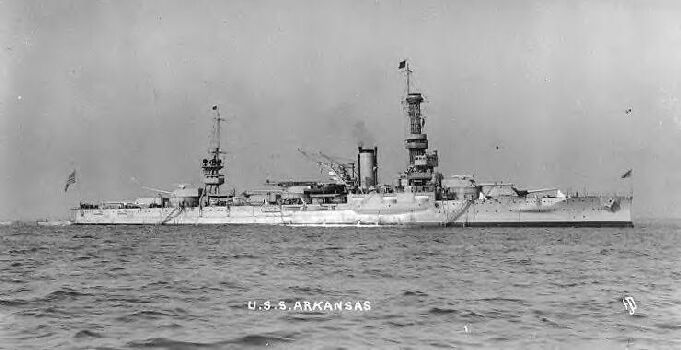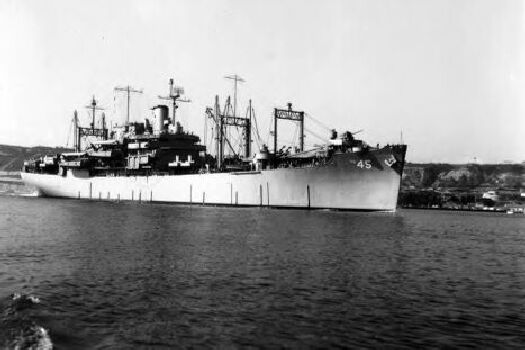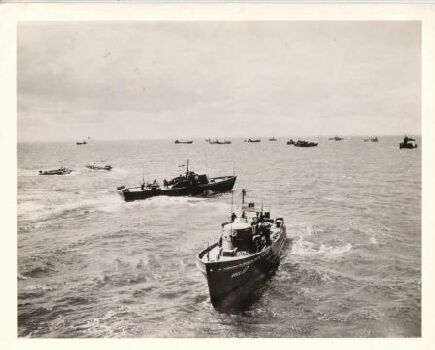 |
| 16th Combat Team. S-3 COMBAT REPORT (Invasion of France) |
| History 16th Combat Team Invasion of France is the single most valuable document regarding the 16th Infantry on D-Day, and how Easy Red sector was won.
Before 10 a.m., the basic events were these. The even line of soldiers that should have landed practically shoulder-to-shoulder on Omaha was broken up by mislandings and fire from the German defenders. Lt. Spalding and his section (like too few others) landed where the fire was less hot. The men took a path off Easy Red, up a slope inland. Meanwhile, Captain Joe Dawson's G Company had landed and also moved up the slope. Dawson and Spalding met near the crest of the hill. Spalding's group moved to the right, westward, toward E-1 draw. G Company moved forward, southward, to Colleville. THE INVASION At H-6 hours the minesweepers ploughed through the Channel, guided by beach markers laid out by midget submarines. At H-4 � hours, the convoy reached Transport Area, 23000 yards from beach OMAHA and dropped anchor. At H-1 hour 16 DD tanks from Company C, 741st Tank Battalion and 16 DD tanks from Company B, 741st Tank Battalion, 6000 yards from beach OMAHA, proceeded toward FOX GREEN and EASY RED, as prearranged, and touched down at H-5 minutes to take suitable firing positions close to the high water line. 26 of the 32 DD tanks sunk, some the instant they submerged, because of rough seas. Of the 6 DD tanks that reached the beach, several were knocked out by enemy AT and artillery fire after firing a few rounds. The 6 DD tanks that reached the beach were landed dry by an LCT. At H-40 minutes, the USS TEXAS and the USS ARKANSAS, 12000 yards from beach OMAHA, fired 10 x 14" and 6 x 5" guns on targets, 14" Air Spot, 65% AP, 35% HC. At H-40 minutes to H-3 minutes the cruiser F.S.GEORGES LEYGUES, 9000 yards from beach OMAHA, fired 6 x 152 mm Rock Salvos on enemy target of AA Gun, 4 Concrete Shelters, 2 Pillboxes, 5 MGs at 67808970 in vicinity of ST LAURENT SUR MER. At H-25 to H-Hour, heavy day bombers of the 9th Air Force bombed enemy strongpoints at 68808950 and 68709843 (vicinity of COLLEVILLE-SUR-MER) consisting of 4 Casements, 3 Concrete Shelters, 5 MGs, 1 AT gun, 3 Pillboxes, 1 Medium Gun, 1 Casement u/c in each strongpoint. Simultaneously, heavy day bombers bombed strongpoint 67609010, 4 Guns in Concrete, 6 MGs, 4 Infantry weapons and strongpoint at 67808970, AA Gun, 4 Concrete Shelters, 2 Pillboxes, 5 MGs, both in the vicinity of ST LAURENT SUR MER - COLLEVILLE SUR MER. The 17 M-4s scheduled to land on beach OMAHA at H-Hour to assist the infantry in the attack were reduced to 8 M-4s that reached the beach. The original plan for these tanks of the 741st Tank Battalion (Company A) with Tank Dozers, was to execute direct high explosive drenching fire on enemy targets. Nine of the 14 M-4s were lost at sea. The 2nd BLT was to land on beach OMAHA, EASY RED with Companies E and F abreast, F on the left, Company G in reserve, Company H in support. At 0330 hours Companies E and F aboard APA # 2, the USS HENRICO, were called to debarkation stations and at 0415 were lowered in LCVPs, continuing to rendezvous until after 0600 hours. During the Naval bombardment a few enemy planes dropped long-burning flares over these LCVPs. To their front, the assault companies observed the LCTs (rockets) moving into firing position. Guide craft and tank ships were out in front as well as support boats. One mile off shore, the LCVPs passed several men tossed about in the rough sea, supported in life belts and in small rubber rafts. It was first believed these men, increasing in number in the water, were shot-down airmen, but before long they were recognized as DD tank men. Their tanks had been sunk or swamped. Between 10 and 15 minutes off shore the LCVPs' personnel observed the rocket ships opening up with thousands of rockets. According to plan, these three rocket ships were to take position in boat lanes and deliver fire at approximately H-3 minutes on enemy strongpoint target between 702891 and 685895 in the vicinity of COLLEVILLE when the leading wave was 500 yards off shore. They fired off schedule. At 500 to 600 yards offshore, the LCVPs subjected to concentrated enemy AT and small arms fire, continued through a thick barrage of mortar, artillery, and automatic-weapon fire. Company E & F schedule to land (Company E right half of beach EASY RED), (Company F left half of beach EASY RED) between 679895 and 688893, were landed to the left of original landing point near the 3rd BLT sector. The men were subjected to MG and AT fire as they waded toward shore. An LCVP received a direct hit from an AT gun, burst into flames, and exploded. There were no men aboard. Three enemy strongpoints, (672900) (679895) (678900), which were to have been bombed, shelled, and wiped out by the Air Force, Navy and rocket guns, were in action. There were no DD tanks to cover the advance of the assault companies. There were no bomb craters on the beach for the men to find cover in from enemy fire. Intense fire concentrated on the group; several men struck underwater mines and were blown out of the sea; others continued to cross the obstacle-covered beach to slowly work up the shale at the high water mark to obtain momentary cover. Beach obstacles were numerous. There were hedgehogs, tetrahedrons, element C, log ramps, curved rails and stakes. A hasty firing line was built up along the pile of shale. Company E discovered most of their weapons were jammed with sand. Personnel stripped, cleaned weapons and enemy guns were brought under small arms fire. Despite the fact that enemy MGs and snipers cut down anyone attempting to return to the water to drag wounded up to the lee of the shale, many men pulled casualties out of the water and were wounded. A few succeeded in face of point-blank fire. With the majority of weapons still jammed, all radio communication gone, an attempt was made to reorganize scattered remnants of Company E for an attack on enemy strongpoint 688895, to their front but only ten men could be found. An attempt to obtain smoke to cover the attack failed. To reorganize in some strength a lateral movement along the exposed beach was started; men were picked up at scattered intervals and led toward Company E's originally scheduled landing point between 679895 and 688893. Here the men were pinned down by enemy fire. A 7 yard beachhead was established. By this time the beachhead was blocked by the crowding of personnel onto the 7 yard penetration. Shoulder to shoulder the men lay prone on the pebbles, stone and shale; some of the personnel on the beach laid in a prone position with bodies half inserted in the water. Landing craft discharged more troops onto the 7 yard beachhead. The third wave, fourth wave, [and] fifth wave found the first wave assault infantry trapped on the beach. [The] 7 yard beachhead, jammed with personnel, remained under constant enemy artillery, mortar, AT, MG, and sniper fire. Casualties mounted with each succeeding wave. Company E found that the first platoon, Company E, had broken through just east of Exit E-1, vicinity of 676900, making initial breakthrough from the beach. Personnel on EASY RED were attempting to clear inland by this route which was swept by enemy MG, AT, mortar, and artillery fire. Mines were thickly sown through this area. Enemy MGs covered this path which led past the ruins of a house. Working their way to the top of the high ground overlooking the beach, the 1st Platoon, led by Lt Spaulding [misspelling of spalding], under covering fire of a platoon from Company G, 16th Infantry, proceeded west to reduce the strongpoint at 678897 consisting of AA Gun, 4 Concrete Shelters, 2 Pillboxes, 5 MG's, pillbox by pillbox to wipe out the strongpoint covering the east side of Exit E-1. Extremely stubborn resistance was encountered in this strongpoint with its maze of underground shelter trenches and dugouts. A close exchange of hand grenades ensued and small arms fire until the 1st Platoon cornered approximately 20 Germans and an officer who, overpowered, surrendered. Remnants of Company E pushed on without communication of any kind and approximately 1000 yards south of E-1 partially reorganized. Of the 183 men that landed, 100 were dead, wounded or missing. Patrols were pushed out to the front until the 1st Battalion took over the job of reducing it. Orders from Battalion via runner, for Company E to move east toward COLLEVILLE-SUR-MER, were immediately carried through. The Company moved east, then south along road towards town. Enemy snipers were active, but the company continued. Heavy enemy artillery fire registered on the company, but suffered no casualties. Upon Battalion order, the company, 50 troops in strength, swept the woods and fields west of COLLEVILLE Road and proceeded to the COLLEVILLE-ST LAURENT road. The Company advanced without serious opposition but the small Headquarters group, following the deployed company, was repeatedly pinned down by MG and sniper fire. It was evident that the enemy fired only on small groups. Meanwhile Company G had moved up to COLLEVILLE-SUR-MER and occupied the west half of the town after a fire fight. Company E, with an attachment of one section of Company H HMGs, was given a mission of building up a Battalion line by covering Company G's right flank which was exposed to enemy MGs and machine pistols. Two skeleton sections of Company E under Lt Huch took positions on Company G's right, with the enemy to the front, amongst and to the rear of the troops. Lt Huch and the men held ground, relieving enemy pressure on Company G's right, and finally established a battalion line. Company G scheduled for the infantry assault wave following Company E and F at H+30 minutes to land on EASY RED. They were loaded from USS HENRICO into assault craft at 0415 hours, rendezvoused 500 yards off the starboard bow until 0445 hours, then proceeded toward the beach. One of the craft capsized 200 yards from the beach, forcing the boat teams to swim ashore minus key equipment and weapons; remainder of the company walked ashore in the face of heavy enemy fire. The number of casualties mounted. Approximately 200 yards inland from a waterline a small shingled mound about 10 feet high enabled the company to secure a slight amount of defilade from fire raking the beach from the flanks and immediate front. Company G found a large number of troops, who had landed at H-hour, pinned down on the beach unable to advance into the bluff overlooking the beach. Company G found most units disorganized due to loss of officers and NCO's on the beach. A hasty reorganization of assault teams was made in Company G and 60mm mortars and MGs were placed in firing position. All efforts were made by a few officers and NCOs to build up a volume of fire. A few elements of the 1st wave, by this time had succeeded in advancing approximately 100 yards in front of this position but were pinned down and unable to move in any direction because of enemy fire concentration. At 0710 hours G Company infiltrated through a narrow gap between minefields flanked by the shingle mound and overlooking a cliff. Lt Spaulding's section, Company E, and remnants of two sections from Company F, 16th Infantry, were pinned down at the base of the cliff. They were told by the Company Commander of G Company that their organizations were supposed to be 500 yards to the right of this position and to move inland and to the right if possible. They proceeded to move forward and slightly to the right. As Company G reached this point the sections were directed to seize high ground to the immediate front and to deploy from right to left as they cleared the crest of the hill, in addition to maintaining contact with two sections of Company E on the right. |
 |
 |
 |
 |
 |
 |
 |
 |
 |
 |
 |
 |
 |
 |
 |